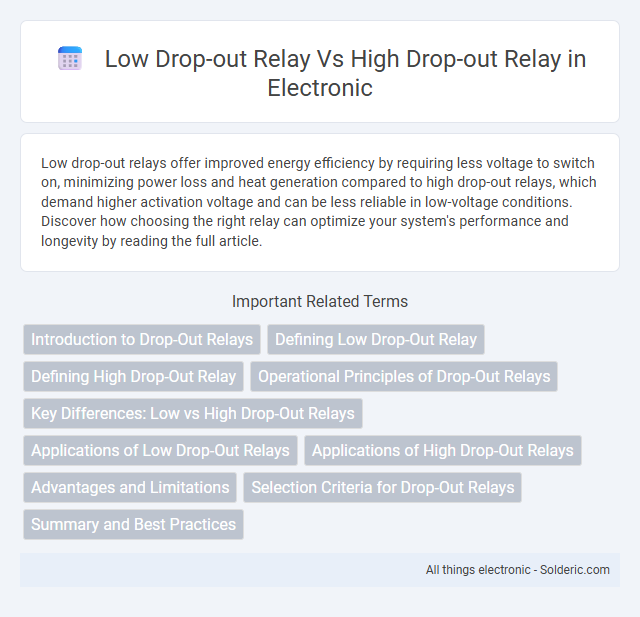Low drop-out relays offer improved energy efficiency by requiring less voltage to switch on, minimizing power loss and heat generation compared to high drop-out relays, which demand higher activation voltage and can be less reliable in low-voltage conditions. Discover how choosing the right relay can optimize your system's performance and longevity by reading the full article.
Comparison Table
| Feature | Low Drop-Out Relay | High Drop-Out Relay |
|---|---|---|
| Definition | Relay that de-energizes at low voltage below hold voltage. | Relay that de-energizes only at higher voltage below hold voltage. |
| Drop-Out Voltage | Typically 10-20% below rated coil voltage. | Typically 30-50% below rated coil voltage. |
| Power Consumption | Lower coil power for sustained holding. | Higher coil power required to maintain activation. |
| Application | Used where voltage stability is critical (e.g., control systems). | Used in circuits needing fail-safe drop-out (e.g., safety relays). |
| Switching Stability | High stability with less risk of chatter. | May experience chatter if voltage fluctuates near drop-out. |
| Cost | Generally higher due to precise coil design. | Usually lower cost, simpler coil design. |
Introduction to Drop-Out Relays
Drop-out relays differ primarily in the voltage level required to de-energize the relay coil, affecting the sensitivity and reliability of circuit interruption. Low drop-out relays release at voltages close to the rated coil voltage, making them ideal for applications needing fast response and minimal residual voltage. Choosing the right drop-out relay ensures your electrical system maintains optimal performance and safety through precise control of relay activation and deactivation thresholds.
Defining Low Drop-Out Relay
A low drop-out relay is designed to operate with a minimal voltage drop between the input and output, ensuring efficient power use and reduced energy loss in electronic circuits. Compared to high drop-out relays, low drop-out relays maintain better performance in low voltage environments, making them ideal for battery-powered or energy-sensitive applications. Understanding the advantages of a low drop-out relay can help you optimize your system's reliability and efficiency.
Defining High Drop-Out Relay
A high drop-out relay is defined by the voltage level at which it de-energizes or drops out, which is significantly higher compared to a low drop-out relay. This characteristic ensures the relay remains activated until the voltage falls to a predetermined high threshold, providing reliable operation in applications where maintaining relay engagement above a certain voltage is critical. Your choice between high drop-out and low drop-out relays depends on the specific voltage sensitivity and stability requirements of your electrical system.
Operational Principles of Drop-Out Relays
Low drop-out relays operate by releasing their contacts at a minimal reduction in coil voltage, ensuring rapid disengagement and precise control in sensitive circuits. High drop-out relays require a significant voltage decrease to release, making them suitable for applications where maintaining contact despite minor power fluctuations is critical. Understanding these operational principles enables you to select the appropriate relay type for stability or sensitivity in your electrical system.
Key Differences: Low vs High Drop-Out Relays
Low drop-out relays require a smaller voltage reduction to switch from the energized to the de-energized state, ensuring quicker release and minimizing power consumption. High drop-out relays need a larger voltage drop to deactivate, providing greater resistance to accidental switching due to voltage fluctuations or noise. Your choice between low and high drop-out relays depends on the sensitivity and stability requirements of your electrical control system.
Applications of Low Drop-Out Relays
Low drop-out relays are ideal for applications requiring minimal voltage loss and efficient power management, such as battery-operated devices, precision instrumentation, and low-voltage control systems. These relays ensure stable switching performance in sensitive electronics by maintaining circuit integrity even under low voltage conditions. Common use cases include portable medical devices, communication equipment, and energy-saving smart home systems.
Applications of High Drop-Out Relays
High drop-out relays are commonly used in applications requiring reliable disconnection under low voltage conditions, such as battery monitoring systems and undervoltage protection circuits. These relays ensure devices remain disengaged until voltage levels return to a safe threshold, preventing malfunctions or damage. Industrial control panels and power supply units often deploy high drop-out relays to maintain circuit integrity and operational safety.
Advantages and Limitations
Low drop-out relays offer the advantage of maintaining coil energization with minimal voltage, improving energy efficiency and reducing heat generation in sensitive electronic circuits. High drop-out relays provide clearer distinction between energized and de-energized states, minimizing false triggering in environments with voltage fluctuations. Your choice depends on whether energy savings or operational reliability under varying voltage conditions is the priority for your application.
Selection Criteria for Drop-Out Relays
Selection criteria for drop-out relays primarily depend on the application's voltage requirements and sensitivity to power fluctuations. Low drop-out relays operate efficiently with minimal voltage reduction, making them ideal for critical circuits requiring stable performance at lower voltage thresholds. High drop-out relays demand higher voltage levels to activate, suitable for applications where increased noise immunity and deliberate triggering thresholds enhance system reliability.
Summary and Best Practices
Low drop-out relays provide faster switching times and reduced voltage drops, making them ideal for sensitive electronic applications requiring precise control and minimal power loss. High drop-out relays, while slower, offer greater durability and are better suited for heavy-duty or high-current environments where robustness outweighs speed. To optimize performance, choose a low drop-out relay for efficiency and signal integrity, but rely on high drop-out relays in scenarios demanding enhanced reliability and tolerance to electrical stress.
low drop-out relay vs high drop-out relay Infographic

 solderic.com
solderic.com